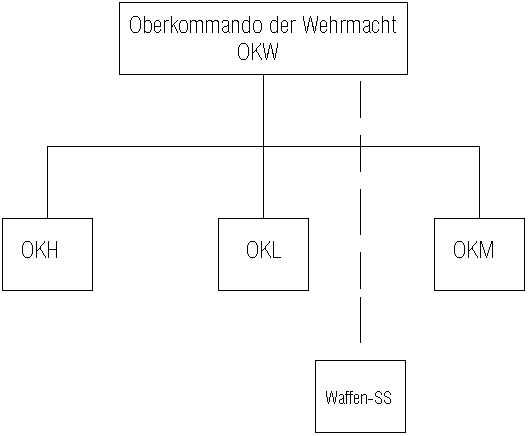Wehrmacht Organization
The German Army in World War II consisted of a number of different arms, or what many would refer to now as branches or services. During WWII, each separate branch was referred to as being an arm of the German military. For example, the Luftwaffe (Air Force) was an arm of the large Wehrmacht (Army), as were the Heer (Land Force), the Waffen-SS (Armed Guard), and the Kriegsmarine (Navy). Within each arm, and sometimes universal throughout the entire Wehrmacht, many smaller arms existed. Arms existed for every military function necessary, and soldiers would serve in the German military in relation to a specific area of training and expertise. Signals, Maintenance, Supply, and Artillery are four examples of different arms within the larger four.
Above all other organizational and administrative structures that controlled the German military and civilian infrastructure, the command and control of the Wehrmacht was the highest organizational position. The Oberkommando der Wehrmacht was the organization responsible for the highest level of administration within the Wehrmacht, it was responsible for the overall control of all the branches of the German armed forces. While the Wehrmacht was the highest command and control structure of the German military, each arm had its own High Command. The Heer had the Oberkommando der Heer (OKH) (Army High Command), the Luftwaffe had the Oberkommando der Luftwaffe (OKL) (Airforce High Command), the Kriegsmarine had the Oberkommando der Kriegsmarine (OKM) (Navy High Command), and lastly, the more-or-less independent Waffen-SS had the Feldkommandoostelle Reichsfuhrer-SS (Field Headquarters of the Reichs Leader-SS). The Waffen-SS, the combat arm of the political organization of the SS, was in times of war, actually tactically under the control of the Oberkommando der Wehrmacht, while still being strategically under the control of its own higher headquarters. Many sources mistakenly refer to the Heer and the Wehrmacht, as being more-or-less equal. In reality, The Heer was the German ground force mainly consisting of the Infantrie (Infantry) and the Panzertruppen (Armor Troops), along with a number of smaller supporting arms. The Wehrmacht was the larger German military structure consisting of each of the four major arms, the Heer, Waffen-SS, Luftwaffe, and Kriegsmarine, and the command structure necessary to control and maintain the above four. The Waffen-SS in this respect was subordinated only tactically to the Wehrmacht and strategically to the Reichsfuhrer-SS. In practice then, the Wehrmacht consisted of The Heer, Luftwaffe, Kriegsmarine, and the High Command structure of the Germany military. |
